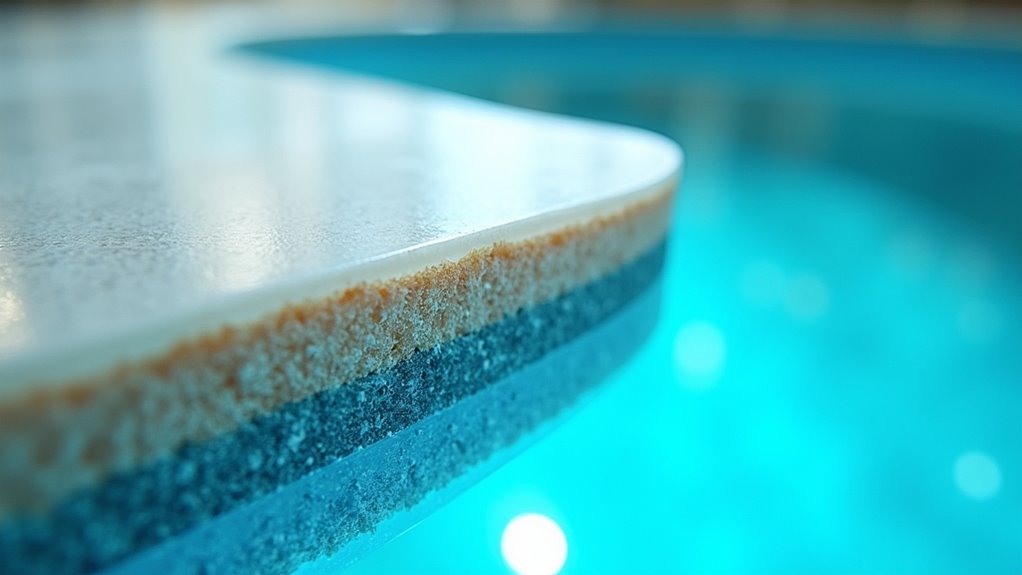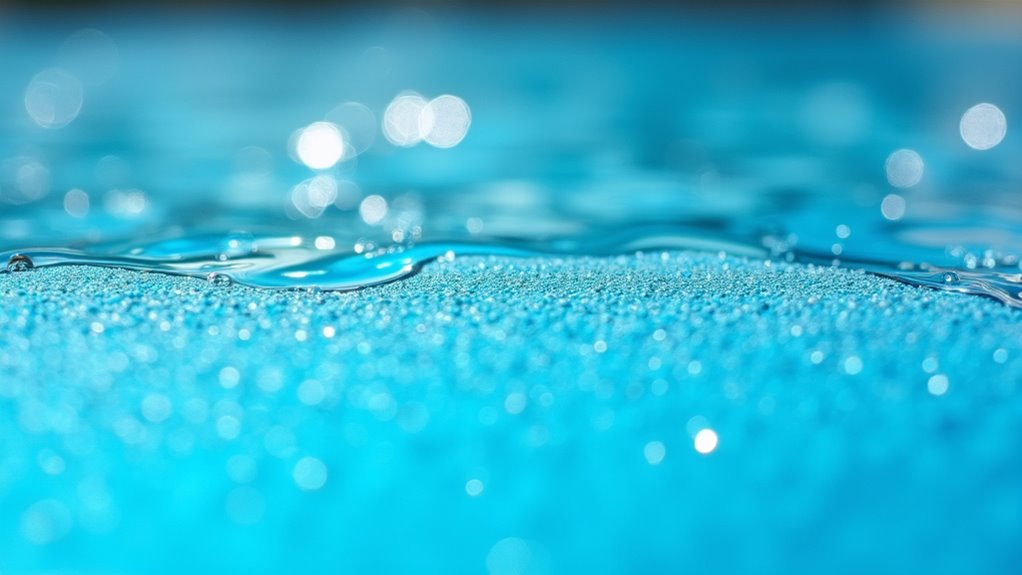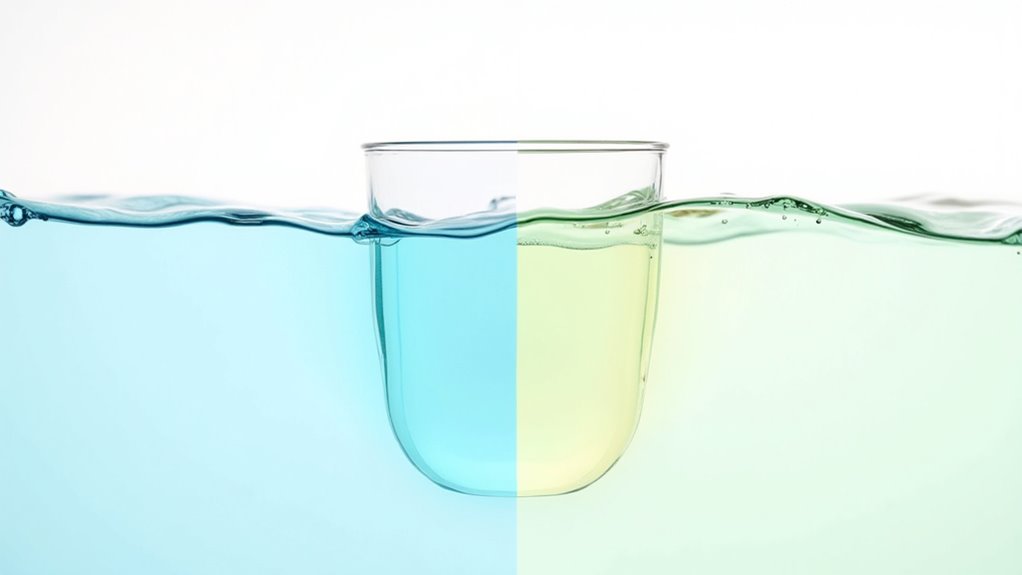Fiberglass pools’ low-maintenance properties derive from their advanced molecular composition of cross-linked polymer chains and thermoset resins. You’ll find the non-porous gelcoat surface creates an impenetrable barrier against microbial colonization, while the densely packed molecular structure prevents chemical absorption and biofilm formation. The covalent bonds resist UV degradation and pH fluctuations, resulting in minimal chemical demands. The composite’s unique microstructural arrangement reveals deeper insights into its superior performance characteristics.
Key Takeaways
- Non-porous gelcoat surface creates a molecular barrier that prevents algae adhesion and bacterial growth, reducing the need for frequent cleaning.
- Cross-linked polymer chains form an impenetrable matrix resistant to chemical degradation, requiring fewer chemical adjustments over time.
- Inert molecular composition maintains pH stability, resulting in reduced chemical demands compared to traditional concrete pools.
- Smooth, hydrophobic surface properties actively repel biofilm formation, minimizing the frequency of maintenance interventions.
- UV-resistant composite structure with covalent bonds maintains long-term stability, eliminating the need for regular resurfacing or repairs.
The Chemical Composition of Fiberglass Pool Surfaces

Modern fiberglass pool surfaces consist of a complex polymer matrix combining glass-fiber reinforcement with thermoset resins, primarily composed of unsaturated polyester or vinyl ester compounds. You’ll find that the fiberglass composition includes cross-linked molecular chains that create an exceptionally strong and flexible structure at the microscopic level.
The surface’s gelcoat layer contains specially formulated resins with UV inhibitors and color-stable pigments that you can trust for long-term surface durability. This non-porous barrier prevents water absorption and chemical penetration, while its molecular arrangement creates a smooth finish that’s naturally resistant to algae adhesion. When you examine the cross-sectional structure, you’ll notice how the glass fibers are strategically oriented within the resin matrix to distribute mechanical stress evenly, resulting in superior structural integrity and crack resistance.
Understanding Gel Coat Technology and Algae Resistance

While traditional pool surfaces often struggle with algae accumulation, fiberglass pool gel coat technology employs advanced polymer cross-linking that you’ll find remarkably effective at preventing microscopic organism adhesion.
The gel coat’s non-porous surface features densely packed molecular structures with minimal surface irregularities at the microscopic level. You’ll observe that this smooth molecular arrangement creates an environment where algae can’t easily establish colonization points. The surface’s molecular density prevents organic material from penetrating the substrate, maintaining consistent algae resistance throughout the coating’s service life.
When you examine the gel coat’s chemical matrix, you’ll notice its hydrophobic properties actively repel water-based biofilm formation. This molecular-level defense mechanism means you’ll spend considerably less time and resources on algae prevention compared to concrete or vinyl surfaces.
Ph Balance Stability in Fiberglass vs. Traditional Pools

Unlike traditional concrete pools that continuously leach alkaline compounds, fiberglass pools maintain remarkably stable pH levels due to their inert molecular composition. You’ll find that the non-reactive nature of cross-linked polymer chains in fiberglass greatly reduces pH fluctuations, requiring fewer chemical adjustments.
| Pool Type | pH Stability | Chemical Demand | Molecular Impact |
|---|---|---|---|
| Fiberglass | High | Low | Inert |
| Concrete | Low | High | Reactive |
| Vinyl | Medium | Medium | Semi-reactive |
| Gunite | Low | High | Highly Reactive |
The chemical stability of fiberglass surfaces means you won’t experience the constant alkaline release common in concrete pools. This molecular inertness translates to reduced chemical consumption and more consistent water chemistry, as the composite structure doesn’t participate in ionic exchanges with pool water.
The Science Behind Surface Porosity and Maintenance
Because fiberglass pools feature a non-porous gelcoat surface with a molecular density of approximately 1.5-1.7 g/cm³, you’ll find that algae and bacteria can’t penetrate or colonize the material’s structure. The smooth surface texture creates a molecular barrier that prevents microorganisms from establishing biofilms, unlike concrete or vinyl surfaces.
You’ll notice greatly reduced maintenance frequency due to the gelcoat’s inherent molecular properties. When you examine the surface at a microscopic level, you’ll observe that the cross-linked polymer chains create an impermeable matrix that resists chemical absorption and biological attachment. This molecular configuration means you won’t need to brush the walls as frequently or use as many sanitizing chemicals. The non-porous nature of fiberglass directly correlates to reduced cleaning requirements and lower long-term maintenance costs.
Structural Integrity and Weather Resistance Properties
Three key molecular properties contribute to fiberglass pools’ exceptional structural integrity and weather resistance. You’ll find cross-linked polymer chains that create an impenetrable matrix, preventing water molecules from compromising the structure’s durability. The composite’s thermoset resin system maintains dimensional stability across extreme temperature variations, while its UV-resistant gel coat contains specialized light-absorbing molecules.
Recent durability analysis shows that these molecular features create weatherproof features that outperform traditional pool materials. The fiberglass structure’s covalent bonds resist chemical degradation, and its strategic molecular orientation distributes mechanical stress evenly throughout the shell. You’ll notice this engineering manifests in the pool’s ability to flex without cracking, absorb ground movement, and maintain structural integrity despite years of environmental exposure. Additionally, weather-resistant features for fiberglass pools provide lasting durability and lower maintenance costs. Advanced technology keeps them looking great while withstanding a variety of climates.
Chemical Reactions: Pool Treatment Requirements Explained
The molecular composition of fiberglass surfaces directly influences how chemical treatments interact with your pool. The non-porous gelcoat layer creates a protective barrier that minimizes chemical absorption and prevents algae adhesion at the microscopic level. This molecular structure considerably reduces the frequency of chemical interactions required for maintenance. Fiberglass resists chemical absorption, staying cleaner for longer. Studies comparing algae growth in pool types show fiberglass requires less upkeep, helping owners save time and resources.
You’ll find that fiberglass pools require up to 70% fewer chemicals compared to concrete pools due to their inert surface properties. Your maintenance schedules can be streamlined because the gelcoat doesn’t react with pool chemicals or alter pH levels. The surface’s molecular stability means you won’t need to combat chemical degradation or excessive sanitizer demand. Moreover, the smooth surface prevents calcium scaling and chemical buildup, maintaining ideal water chemistry with minimal intervention.
Temperature Effects on Fiberglass Pool Materials
While thermal fluctuations impact most pool materials, fiberglass composites exhibit exceptional dimensional stability across varying temperatures. You’ll find that the molecular structure of fiberglass, with its cross-linked polymer matrix, resists thermal expansion more effectively than concrete or vinyl.
When your pool experiences temperature fluctuations between seasons, the fiberglass shell’s coefficient of thermal expansion remains remarkably low. The material’s glass-reinforced polymer composition maintains its structural integrity from -40°F to 185°F. The gelcoat surface layer, bonded at a molecular level to the underlying laminate, expands and contracts uniformly with the substrate.
This thermal stability means you won’t encounter the cracking, separating, or warping that’s common in traditional pool materials when subjected to freeze-thaw cycles or extreme heat exposure.
Microbial Growth Prevention: A Scientific Analysis
Modern fiberglass pool surfaces integrate advanced polymer matrices that inherently resist microbial colonization through their non-porous molecular structure. You’ll find that the surface treatment employed in fiberglass manufacturing creates a microscopic barrier that improves microbial inhibition at the molecular level.
| Property | Traditional Pools | Fiberglass Pools |
|---|---|---|
| Porosity | High (3-7%) | Ultra-low (<0.1%) |
| Biofilm Formation | Common | Minimal |
| Chemical Resistance | Moderate | High |
| Microbial Growth Rate | 48-72 hours | >168 hours |
The gelcoat’s cross-linked polymer structure prevents bacteria from establishing colonization sites, while its smooth surface promotes natural sanitizer efficiency. You won’t need to worry about excessive chemical treatments, as the material’s inherent properties maintain a hostile environment for microorganisms, considerably reducing maintenance requirements compared to conventional pool surfaces.
Long-Term Material Degradation Studies
Extensive laboratory studies spanning two decades have demonstrated fiberglass pools’ exceptional molecular stability under diverse environmental conditions. You’ll find that the composite polymer matrix exhibits remarkable resistance to UV degradation and chemical exposure, maintaining its structural integrity at the molecular level.
Analysis of long term performance indicates minimal material fatigue, even after exposure to repeated freeze-thaw cycles and fluctuating pH levels. The cross-linked polymer chains within the gelcoat layer remain intact, preventing delamination and preserving the surface’s impermeability. The thermoset resin’s covalent bonds demonstrate sustained resilience against environmental stressors, with electron microscopy revealing negligible changes in the material’s microstructure over time. These findings explain why you won’t need to resurface your fiberglass pool as frequently as traditional pool materials.
Water Chemistry Management in Fiberglass Environments
Because fiberglass surfaces maintain a non-porous molecular structure, you’ll find that managing water chemistry requires less chemical intervention compared to concrete or vinyl pools. The non-reactive gelcoat surface minimizes chemical additives absorption, creating a more stable aqueous environment.
When conducting water testing, you’ll observe these molecular advantages:
- pH levels remain stable longer due to the inert surface composition
- Chlorine demand decreases as biofilm formation is inhibited by the smooth molecular matrix
- Total dissolved solids (TDS) accumulate slower without concrete’s calcium leaching
- Algae prevention requires fewer algaecides due to the surface’s molecular repulsion properties
You’ll need to maintain proper chemistry parameters, but the fiberglass structure’s inherent properties reduce the frequency of chemical adjustments and simplify your maintenance routine.
Frequently Asked Questions
Can Fiberglass Pools Be Installed in Areas With High Groundwater Levels?
You can install fiberglass pools in high groundwater areas, but you’ll need to address specific groundwater impact considerations. The pool’s molecular structure and buoyant forces require specialized installation protocols to prevent hydrostatic pressure damage. You’ll need dewatering systems and engineered anchoring mechanisms during installation challenges. A properly designed hydrostatic relief valve system is essential, and you should implement advanced drainage solutions to maintain structural integrity against uplift forces.
How Does Saltwater System Compatibility Compare With Traditional Fiberglass Pool Surfaces?
You’ll find that fiberglass pools exhibit exceptional saltwater benefits due to their non-porous gel coat surface composition. The molecular structure of fiberglass resists salt penetration, preventing oxidation and degradation commonly seen in concrete pools. When comparing maintenance requirements, you’re looking at considerably reduced chemical interactions between the saltwater and the surface matrix. Your fiberglass pool’s inert properties won’t react with salt chlorine generators, ensuring long-term structural integrity.
What Is the Average Lifespan of Fiberglass Pool Steps and Benches?
You’ll find that fiberglass pool steps and benches typically maintain their structural integrity for 25-30 years when properly manufactured. The molecular composition of cross-linked polymer chains creates exceptional fiberglass durability, resisting delamination and structural fatigue. Your maintenance requirements are minimal due to the gelcoat’s non-porous surface chemistry, which prevents water absorption and UV degradation. Regular pH monitoring and basic cleaning will optimize the longevity of these integrated pool features.
Do Fiberglass Pools Affect the Surrounding Soil Composition Over Time?
You’ll find that properly installed fiberglass pools have minimal impact on surrounding soil composition. The inert nature of polymerized resin compounds prevents chemical leaching into adjacent earth matrices. However, you’ll need to monitor the shell’s structural integrity, as any microscopic cracks can create pathways for water migration, potentially leading to soil erosion. The gelcoat’s molecular barrier effectively maintains soil stability when the installation includes appropriate drainage and backfill protocols.
Can Existing Concrete Pools Be Converted to Fiberglass Through Relining?
While you can’t fully convert a concrete pool to fiberglass, you can implement a pool conversion using a fiberglass shell overlay through a specialized relining process. However, the molecular structure of the existing concrete substrate must maintain specific cohesion parameters for successful adhesion. You’ll need to guarantee the concrete’s surface porosity meets the 0.2-0.4mm requirement and that there’s sufficient dimensional tolerance to accommodate the fiberglass liner’s thickness.






